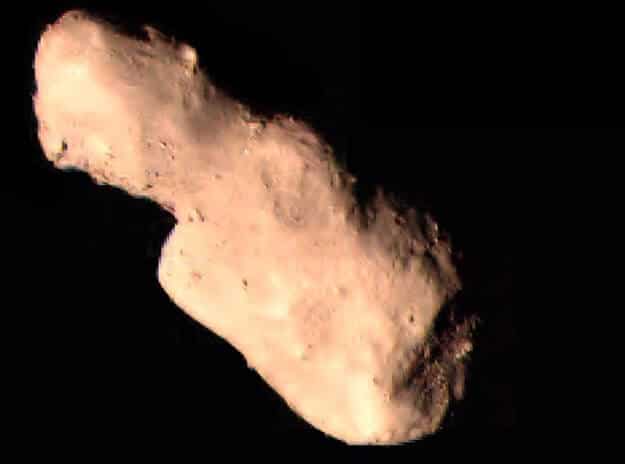The asteroid Toutatis belongs to the group of asteroids that pass by the Earth during their orbit around the Sun.

The asteroid Toutatis belongs to the group of asteroids that pass by the Earth during their orbit around the Sun. Based on the observations and measurements made, it was clear that it would pass by the Earth on 12.12.2012 and indeed it did. Its transit distance was 7 million km. The NASA radar stationed in the Mojuve Desert in the USA aimed to observe the asteroid between 2012 and 22.12. In this observation, a series of observations was produced based on high-resolution photographs of the asteroid. Considering that it is 4.12.2012 km long. It was possible to appreciate the high accuracy of these photographs, several craters and formations of channels could be distinguished. on his face (4.5).
A day after this transit flight on 13.12, the Chinese spacecraft Chang'e 2 passed by the asteroid. The crossing distance was 3.2 km. This spacecraft was originally a lunar spacecraft. A few days after launch, it entered orbit around the moon. 8 months later she finished her mission. There was enough fuel left in the tank and it was decided to put it into orbit around the Earth at one of the points in Lagrange. When it became clear that this asteroid was supposed to pass by the Earth, it was decided to take the spacecraft out of Earth's orbit and we planned a flight path for it that would bring it close to the asteroid. This mission was fully accomplished.
Due to the small crossing distance, the photographs were of high resolution 10 meters per pixel. The researchers had the opportunity to make a comparison between radar photographs and visible light photographs of the same asteroid (2).
It turned out that the asteroid is made of two parts, a narrow part that is 2.4 km wide and the width of the other part that is 4.6 km wide. km. It rotates around its longitudinal axis 5.38 times itself and orbits the Sun once every 4.02 years (3). It is made of silicates. The fact that it has two parts, each of which has different dimensions, raises the possibility that it is two asteroids that collided with each other and stuck to each other. What supports this hypothesis is the density differences between the two parts of the asteroid. The density of the narrow part is 15% greater than that of the wide part (1). The number of craters on its surface is small.
A few craters have a large diameter relative to their dimensions. The diameter of the largest of them is 2.25 km. The diameter of the others is tens of meters. You can clearly see the dust covering part of his face (3).
Another closely watched asteroid is Stein. The spacecraft that passed by is the Rosetta that is on its way to the comet Chuyavov. The passage was made on September 5.9.2008, 4.6. It turned out that its shape is like a diamond and it is 800 km long. The distance of the passage was 4.6 km from its surface. Based on national observations, the estimate was that it was 3.63 km long. It orbits the sun once every 6 years and rotates around itself once every 4.47 hours. The photographs showed that its shape is like a diamond. Its dimensions are 5.8 X 6.67 X 4 km and it is covered with many craters (2). The diameter of a large crater located at the South Pole is 300 km and its depth is 650 meters. Inside these craters are small craters. A crater named Topaz, 80 meters long and 40 meters deep. On the side seen by the spacecraft is a chain of craters from the North Pole to the South Pole. A total of 5 craters were counted on its surface (6). The asteroid is mainly made of silicates and basalt (XNUMX).
These two asteroids have more or less similar dimensions and therefore their surface areas are also close to each other. One is crowded with craters and the other a little. This fact can serve as a basis for future comparisons between small asteroids. A possible reason for this discrepancy between the numbers of craters is that they both probably passed through different areas in the asteroid belt.. One area is dense with a number of craters per unit volume and the density in the other area is smaller (hypothesis of the writer Haim Mazar).
Sources
1. Philips T. – "Big asteroid Tumbles harmlessly past Earth" 13.12.2012
http://www.spacedaily.com/reports/Big_Asteroid_Tautatis_Harmlessly_Past_Earth
_999.html
2. "China makes first asteroid fly by" 17.12.2012
http://www.spacedaily.com/reports/China_Makes_First_Asteroid_Fly_By_999.html
3. 4179 Toutatis
http://en.wikipedia.org/wiki/4179 Toutatis
4. "Rozetta's OSIRIS cameras reveal the nature of asteroid Stein" 13. 1.2010
http://www.spacedaily.com/reports/Rozetta’s_OSIRIS_Cameras_Reveal_The_ Nature_ Of_ Asteroid_ Stein_999.html
5. "Asteroid Stein's hidden gems" 20.2.2013
http://www.spacedaily.com/reports/Asteroid_Steins_Hidden_Gems_999.html
6."Rosetta swings by asteroid Steins on routes to comet Churyunov" 5.9.2008
http://www.spacedaily.com/reports/Rosetta_Swings_By_Asteroid_Steins_On_Routs _To_ Comet_ Churyunov _999.html

4 תגובות
Nissan
You're right. From the tests I did I came to the conclusion that indeed in the distant past in the space of asteroids there was indeed a planet. Furthermore, in several asteroids the spectroscopic observations have hints of the presence of diamonds and these can only form at great depths. Diamonds cannot form on a block of rock tens of kilometers long.
nice
You're right. From the tests I did I came to the conclusion that indeed in the distant past in the space of asteroids there was indeed a planet. Furthermore, in several asteroids the spectroscopic observations have hints of the presence of diamonds and these can only form at great depths. Diamonds cannot form on a block of rock tens of kilometers long.
Basalt on Stein!
After all, basalt is a product of volcanic activity.
Could it be that there was a part of the planet that would disintegrate?
What are the asteroids prepared for the space mission of capturing an asteroid and bringing it to Israel?
https://www.hayadan.org.il/nasa-explains-their-new-asteroid-retrieval-mission-120413/